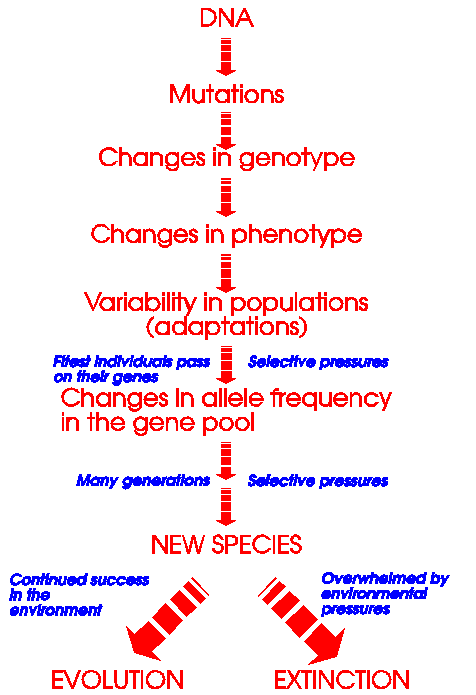

EVOLUTION
"All the changes that have transformed life on Earth from its earliest beginnings to the diversity that exists today."
The currently accepted theories of evolution have been developed and refined by biologists as evidence has become available to support and extend the mechanisms first proposed by Alfred Wallace and Charles Darwin. Earlier explanations, especially those of Lamarck are not well supported by the current evidence and are generally not accepted by current scientists.
The evidence upon which the current theories of evolution are based is varied in its origins, and it is this multi-faceted approach which, taken together provides the strength of the theory.
| You are, however, urged to adopt a pragmatic approach to your study of this part of the VCE course and to try to understand the current scientific explanations - that is what you need to gain marks on CAT 3 questions! |
FOSSIL
"A relic or impression of an organism from the past, usually preserved in rock."
Fossils are most often found in sedimentary rocks such as sandstone, mudstone, shale and limestone. The layers of silt or other debris which accumulate over time exert pressure on plant and animal remains, or settle into the imprints left by passing animals, minerals are exchanged, and fossils are formed.
![]() Back to the top of this page
Back to the top of this page
STRATIGRAPHY
"The science of study of rock strata (layers).
Often asocoated with estimations of the ages of the rocks by the ages of the fossils found within them.
Similarly, succession of rock composition, and events associated with deposition of each stratum, can be inferred from the rocks and the presence/absence of fossils within them."
Over thousands and millions of years sedimentary rocks form in strata, or layers. As a consequence of this, the layers reflect the order in which the fossils were deposited; the oldest fossils are in the lowest layers, with progressively "younger" fossils in each higher layer. This stratification of the sedimentary rock enables palaeobiologists to assign relative ages to fossils. Where similar fossils are discovered at different, separated locations, these index fossils can be used to correlate evolutionary events at the different locations, by comparing and contrasting the fossils in the strata above and below them.
Analysis of fossils in strata does not give dates in terms of years, but only in terms such as before or after and early or late. This is known as relative dating. (Nothing to do with going to a movie with your cousin! Sorry, I couldn't resist.)
However, if the fossils or the rocks in which they are found, can be dated using radioisotopic methods, then absolute dates may be obtained.
Because of the constant, slow movement of the Earth's crustal plates (plate tectonics), the strata in some locations have been buckled and broken. This causes some difficulty in the interpretation of the fossil record in these places but a combination of geology and biology can be used to infer what has happened.
RADIOISOTOPES
An isotope is one of several forms of a particular element. Isotopes differ from each other in atomic arrangement, but they all behave identically in terms of chemical reactions.
Some naturally-occuring isotopes are radioactive - they release energy in a measurable, constant, characteristic way.
Radioactive isotopes gradually decay to form other, non-radioactive elements."
This method relies on the properties of naturally occurring radioactive isotopes to determine the age in years of rocks and the fossils within them. These isotopes are present in constant amounts in living organisms. Since radioactive isotopes have known half lives (the time taken for the radioactivity to decay to half its initial value), measurement of the radioactivity in a sample can easily be calculated as a function of number of years since death occurred.
Carbon-14 dating is most useful for relatively recent fossils, that is fossils up to about 50 000 years old. Isotopes of other elements, such as potassium-40 are used to date rocks which are hundreds of millions of years old and so infer the age of fossils embedded in them. Other elements also have isotopes that are useful in fossil dating. The experts in such matters choose the best isotope for the predicted age of the fossil they are dating.
Radioactive dating has an error of approximately plus/minus 10%.
BIOGEOGRAPHY
"The study of past and present distribution of species."
By studying and comparing similarities and differences in present species environments and their global distribution, inferences can be made about the likely environments of extinct similar species which are now only known from the fossil record.
Study of the biogeography of islands is also instructive in the study of evolution as initially barren locations (such as the island remaining after the eruption of Krakatoa) have given valuable information about succession in such environments. The events during the much longer time span of evolution of life and ecosystems on planet Earth become a logical extension of such an investigation.
ANATOMY
"The structure of organisms."
By comparing the anatomy of species, gradual progressions in structural characteristics can be observed.
For example, comparison of skulls of gorillas, chimpanzees, oranutangs, humans and many now extinct anthropoids has made it possible to suggest pathways of evolutionary progression from common primate ancestor to the existing species.
When combined with radioactive dating of the fossils, the timing of this evolution can also be estimated.
When comparisons are made of the anatomy of structures which seem to have evolved very different functions, it can be seen that the process of natural selection has led to these differences. Homologous structures such as the forelimbs of a variety of mammals (eg human, cat, whale and bat) can be shown to possess the same skeletal elements, suggesting that a common ancestral forelimb has been modified for many different functions.
Homologous structures such as those described above should not be confused with analogous structures (eg bat wing and insect wing), where evolution has given rise to anatomically very different structures which have similar function (aid in flying) where this function provides a survival advantage in a particular environment.
EMBRYOLOGY
"The study of the developing embryo (stage from fertilisation to hatching or birth in animals) in animals or plants."
Closely related organisms go through similar stages in their embryonic development.
In fact, the similarities between early embryos of fish, frogs, snakes, birds, cats and humans are much more evident than are the subtle differences.
By following the progression of development of embryos, and studying the paths of differentiation of tissues in different species, many similarities between species which are difficult to detect in adults become increasingly clear.
BIOCHEMISTRY
"The study of the chemistry of living organisms."
With recent technological advances in the analysis of the molecular composition of biological molecules, some of the most compelling evidence for evolution has been discovered.
Since the hereditary information of an individual is located in its genes, we would expect that closely related individuals (eg siblings) would have a large amount of very similar DNA and proteins. This is found to be true.
For the same reason, we would expect that members of the same species would also possess much common DNA and many common amino acid sequences in their proteins. This is also found to be true.
Examination of nucleotide sequences in DNA and amino acid sequences in similar proteins from a large number of species has shown conclusively that closely related species have much in common biochemically, whilst evolutionary distance (and time for accumulation of mutations) leads to wider and wider differences between phenotypes, genotypes, proteins and DNA.
EVOLUTION
"Evolution is the accumulation of inheritable changes within popluations over time."
Of these, only natural selection leads to adaptations in populations within their changing environments. The others merely produce new opportunities for natural selection to work. However, without mutations to provide the raw material on which natural selection can work, the variability in populations would be strictly limited.
With this in mind, it is possible to trace the evolutionary pathways taken from ancient ancestral species to the present day species. Whilst the biochemical thread of evidence is only possible to trace in current species, the combined information of the ancient fossil evidence and our understanding of relationships between present species together provides powerful support for the modern theory of evolution.
DIVERGENT EVOLUTION
"One ancestral stock evolves into two species, which continue to evolve and become less and less alike over time."
 |
The ancestral mammal probably existed about 190 million years ago. It was around at the time of the dinosaurs, but with the extinction of the dinoasurs, the mammals were able to undergo extensive adaptive radiation to fill a wide range of ecological niches. |
PARALLEL EVOLUTION
"In PARALLEL EVOLUTION two related species arise from a common ancestor. The two species then evolve in much the same way over time, probably in response to similar environmental selection pressures."
| In this example, both the wooly mammoth, which occupied parts of North America, and the elephant, still found in Asia and Africa are presumed to have evolved from a common ancestor. Their geographical isolation and environmental selection pressures caused further evolution of the species, but each, in its own location, occupies(d) a similar niche. | 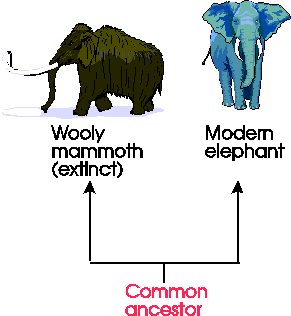
|
CONVERGENT EVOLUTION
"CONVERGENT EVOLUTION occurs when two or more groups that are not closely related come to resemble each other more and more as time passes. This is usually the result of occupation of similar habitats and the adoption of similar environmental roles.."
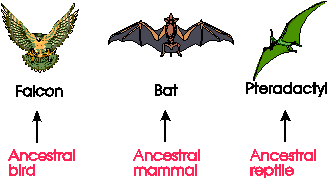
|
From three very different ancestral sources, three flying animals evolved. |
You will see several types of diagrams in evolution chapters of text books. You may even be asked to interpret such a diagram as part of an exam question. It helps to recognise the three main types of diagrams and understand what each is representing.
This type of diagram illustrates one view of the rate of evolution. It shows a branching of an evolutionary path, from a common ancestor, and the gradual emergence of one or more new, different species. The gradual slope of the branches indicates that many intermediate forms of the organism are believed to have existed although evidence of them (usually by fossils) is absent or incomplete.
These diagrams may or may not be accompanied by time scales. The time scales may or may not be linear.
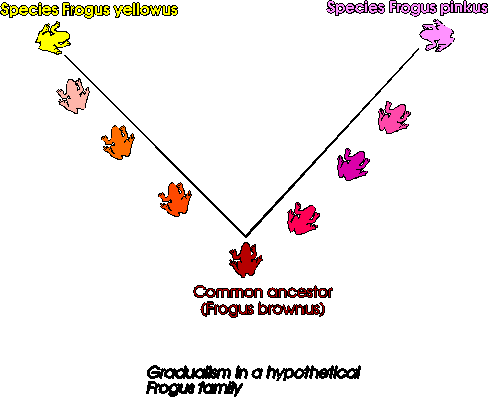
This type of diagram reflects the theory that evolution has not ocurred at a constant rate, rather it has occurred in short bursts with long periods of stability between. This theory explains the absence of the infinite range of intermediate fossils in branches of evolution such as the vertebrates. These diagrams may or may not be accompanied by time scales. The time scales may or may not be linear. |
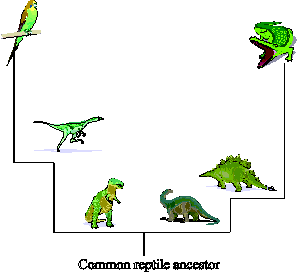 |
This type of diagram reflects the evolution relationships of organisms based on the distance from common ancestors. Again, they may or may not give an indication of time.
Cladograms are often constructed on the basis of biochemical evidence, these days DNA homology is the most useful. If there is very little difference in the DNA of two species, they are said to show evolutionary 'closeness', since there has not been sufficient time for many mutations to accumulate in their DNA. Similarly, the more different the DNA (the less homology shown), the further the evolutionary distance between the species and the longer the time since they shared a common ancestor.
Cladograms take one of two forms, but each shows essentially the same information. If you look closely you can see that they are sometimes similar to pedigree diagrams in construction. However the branches of a cladogram represents the development of a new species, not just a new generation.
| This simple mammalian cladogram shows that dingos (placental) and koalas (marsupial) are more closely related than either are to the platypus (monotreme). | 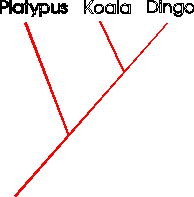
|
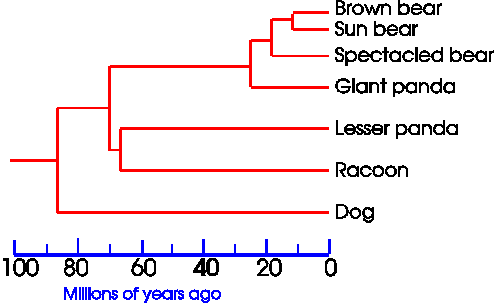
|
This more complex cladogram shows not only the relationships between bears, panda and dogs, but it gives an idea of time since these animals shared common ancestors. |
Time scales are often included on evolution diagrams. Take care with the interpretation of these.
Carefully find the point on the scale that represents 'the present'. This might be at the top or bottom of a vertical time scale, or it might be at the far right of a horizontal time scale.
Next look at the scale's label. Is it m.y.a. (millions of years ago)? or perhaps m.y.b.p. (millions of years before the present)? or something else? You need to know this before you can sensibly use the time scale to determine the age of fossils or events represented on it.
Last, get the information that you want from the time scale, remembering that the scale usually appears to go 'backwards', so interpolation between markers should be thought about carefully.
If you're asked to do this in an exam you are very silly if you don't rule straight pencil construction lines on your exam paper to guide your reading of an evolution diagram. There are hundreds of students who, in the past, have used a rough estimate in such cases, been too far off the correct answer and lost the chance of a mark!
